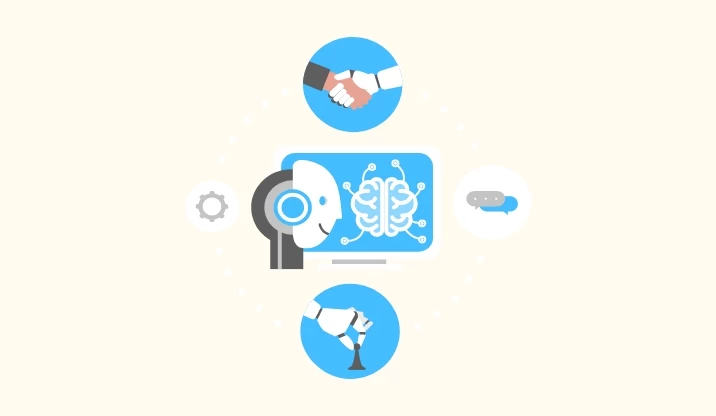Machine Learning (ML) is a part of Artificial Intelligence (AI) that gives the ability to computers or machines to read data even without any specific program. ML helps computers boost their performance on a particular task automatically through experience. It focuses on the way of using algorithms and data for imitating human beings in terms of how they learn while maintaining accuracy.
Machine Learning nowadays witnessed its growing use in multiple industries be it finance, healthcare, entertainment, and transportation. Some popular uses of this technology in these industries are fraud detection speech, image recognition, autonomous vehicles, recommender systems, and more.
The algorithm of ML heavily relies on statistics and mathematical optimization. Some of the popular ML libraries and frameworks are PyTorch, TensorFlow, and Scikit-learn.
How Machine Learning Works?
Machine Learning enables the machine to learn directly from data even without explicitly programming. In other words, ML involves creating an algorithm that can learn automatically and improve the overall experience.
The major purpose of ML is to develop an algorithm or mathematical model that learns directly from examples, identify relationships and patterns in the data, and use this kind of information for making decisions or prediction related to new data. To do this, the ML algorithm should be trained on a larger dataset, for example, popular as training data.
Let’s discuss here several steps of the process of training an ML algorithm. Take a look.
1. Data Collection
Data collection is the first and the most crucial step in an ML project. It involves the collection of relevant data to use for training and algorithms. Data comes from multiple sources including databases, sensors, online sources, etc.
2. Data Preparation
After the completion of data collection, you need to clean. Preprocessing is the best way for eliminating any kind of error from data. It also makes data free from any missing values and inconsistency. It also involves various other tasks including data normalization, dimensionality reduction, and feature selection.
3. Selecting Model
It’s another crucial step that involves the selection of the right ML algorithm that helps analyze the data. It also depends on the nature of the issue and also the type of data and desired results.
4. Training
After the selection of the right algorithm, the training process takes place. During the training phase, the algorithm makes certain adjustments in its internal parameters for reducing the actual differences between the actual and predicted output in the training data.
5. Evaluation
Once the training process is over, the overall performance of the algorithm is then determined on a separate dataset, which is popular as test data. It helps you assess the way the algorithm generalizes to new data.
6. Deployment
It’s the final step that involves deployment of the trained model for making decisions or predictions on new data.
Top 4 Types of Machine Learning
There are various types of Machine Learning algorithms. Each of the algorithms is available with its own set of strengths and weaknesses. Some of these algorithms are Supervised Learning, Unsupervised Learning, Semi-Supervised Machine Learning, and Reinforcement Learning. Let’s discuss each in detail.
1. Supervised Machine Learning
Supervised Machine Learning advocates the use of ‘labelled’ dataset to train the machine. In this, ‘labelled’ data indicates that some inputs are already influencing the output. In other words, Supervised Machine Learning involves training machines with the specific input corresponding to outcomes and then we use the machine for predicting output with the use of a test dataset.
We will take some examples here to understand Supervised Machine Learning. For instance, if you have some images of elephants as an input dataset, you should first train a machine to get a better understanding of images in terms of the shape and size of animals featured in images. The machine should understand the eyes’ shape, height, color, and tail of elephants.
After the completion of training, you can provide input as the image of an elephant. Now, the machine will check and analyze every important feature of the object, including color, shape, eyes, height, tail, etc., and then identify the animal as an elephant. In this process, ML identifies any items in supervised learning.
2. Unsupervised Machine Learning
Unsupervised Machine Learning is the opposite of Supervised Machine Learning. It doesn’t need supervision. In this, the unlabeled dataset is used to train the machine. It enables the machine to predict any kind of output even without any supervision.
The major purpose of unsupervised machine learning is to analyze the representation of the data that is meant to be for further visualization or analysis. Dimensionality reduction and clustering are the two important categories of Unsupervised Learning.
Let’s understand Unsupervised Machine Learning with an example. For instance, we use images of baskets full of fruit as input into an ML model. Since the input is new to the machine. So, the machine analyzes patterns and differences including shape, and color difference, and predicts the final output after testing it with the test dataset.
3. Reinforcement Machine Learning
In Reinforcement Machine Learning, agents generally interact with an environment for making a decision. And they receive either awards or penalties for their actions. This kind of machine learning involves learning the policy that can improve the cumulative reward over time.
Reinforcement Machine Learning is apt for robotics, game playing, and also for autonomous driving.
4. Semi-Supervised Learning
It’s another important type of machine learning that is in between Supervised ML and Unsupervised ML. It reflects the use of both unlabelled and labelled datasets when the training period takes place. Meanwhile, it mainly includes unlabeled data. The main goal of this type of ML is to use all the available data effectively.
Top 10 Applications of Machine Learning
Machine Learning witnessed its various applications in different industries. Let’s discuss its applications industry-wise.
1. Healthcare
Healthcare is one of the sectors that adopted this technology after identifying its potential to complete lots of tasks. With the use of ML algorithms, healthcare professionals can observe the vast amount of data to find out the patterns and also trends, which helps diagnose diseases.
Based on this, they suggest the most suitable treatment plan for patients. ML also makes it possible for healthcare professionals to offer a personalized treatment plan for patients based on their health data.
2. Marketing
Marketing professionals also leverage Machine Learning to analyze important data related to customers. It helps them get an idea of customer behavior. This type of information is useful for them when it comes to creating targeted marketing campaigns that improve sales, conversion, and ROI.
3. Finance
Finance is another industry that has adopted Machine Learning to redefine its work. Professionals use this technology to observe financial data, which helps them predict accurate market trends. Apart from this, they can also get a better idea related to investment opportunities. ML also brings the possibility for these professionals to detect fraudulent activities, identify potential defaulters, and assess credit risk. Financial institutions can also make informed lending decisions with the use of this technology.
4. Education
Machine Learning has also transformed the education industry by redefining the learning experience of students. ML algorithms help analyze student data, which helps recognize the strengths and weaknesses and also build a fully customized learning plan. It helps you tailor the right learning plans based on the specific needs of learners.
5. Manufacturing
Machine Learning simplifies the complicated workflow in the manufacturing industry. It helps professionals analyze data to optimize the process to improve production efficiency, equipment maintenance, etc. The technology also helps professionals to make an exact prediction of equipment failures and also their scheduled maintenance.
6. Transportation
ML also makes it possible to enhance transportation systems by analyzing data and also predict different traffic patterns. This information is crucial to optimize traffic flow, improving road safety and minimizing congestion.
7. Agriculture
In agriculture, ML helps in optimizing crop yields by analyzing data on the weather pattern, soil quality, and various other factors that have a direct impact on the growth of the crop. With this technology, experts can predict diseases and pests that can harm crops and thus encourage farmers to take necessary actions.
8. Natural Language Processing (NLP)
Another important application of Machine Learning is creating natural language processing systems, which can easily understand and also interpret human language. With the use of NLP, professionals create chatbots that can directly interact with customers. Besides, it’s also helpful in analyzing data related to social media to get details of customer sentiment.
9. Energy
ML has the potential to optimize energy consumption and thus can minimize cost by analyzing data related to energy usage patterns. Its algorithms are helpful when it comes to identifying opportunities for minimizing energy consumption including turning off lights or adjusting temperature settings, especially when not in use.
10. Develop Computer Vision
ML is also used for developing computer vision systems that help analyze and also the interpretation of images and videos.
Top 5 Advantages of Machine Learning
ML brings numerous advantages no matter which industry uses it. Some of the advantages of this technology include;
1) Predictive Analysis
One of the major advantages of using ML is its ability to help in predicting outcomes based on historical data. For instance, ML algorithms help analyze historical sales data for the prediction of future sales trends. It’s helpful for businesses in planning their production, inventory, and also marketing strategies. Predictive analysis is also helpful for the Healthcare sector to predict any patients developing any particular disease based on their medical history.
2) Automation
Automation has become an emerging concept among many industries for restructuring their operations. And automation is possible through Machine Learning. ML algorithms can be trained to do various tasks including image recognition, data analysis, and many more even without the need for human intervention. It helps organizations save time and also minimize the risk of inconsistencies and errors caused by human beings.
3) Personalization
By harnessing the potential advantages of ML, businesses can personalize their offerings to match the specific requirements of each customer. For instance, eCommerce businesses can use Machine Learning algorithms to observe customers’ purchasing and browsing history. Based on these details, they can recommend the right products to customers accordingly.
4) Make Customer Experience Better
Machine Learning is helpful for businesses to provide excellent services with improved customer experience. For instance, a chatbot developed on ML can interact with customers and can answer their queries in real time. And more, its algorithms can also analyze the feedback of customers and suggest better improvements.
5) Improved Decision Making
ML helps businesses make the right decision by going through insights into complicated data sets that can be complex for humans to analyze. For instance, ML algorithms can observe customer data for identifying patterns and also trends for optimizing marketing strategies.
6) Cost Saving
Cost saving is another prominent advantage of Machine Learning. Businesses find the possibility of automating most of their tasks with the use of this technology. For this, they don’t even need any human intervention. Businesses can use ML algorithms for the optimization of the supply chain and reduce transportation and inventory costs.
Conclusion
As the most crucial part of modern-day technology, Machine Learning has unmatched potential to take businesses to a new height. This is the reason why multiple industries adopted this technology to a wider extent. It reflects that the technology will be in more demand in the coming times as well.
Frequently Asked Questions (FAQs)
1. What is Machine Learning?
Machine Learning is a part of Artificial Intelligence, which gives machines the capability of using algorithms and data to imitate human behavior. It also gives the ability of software to predict outcomes with more accuracy.
2. What are the types of Machine Learning?
There are four types of Machine Learning: Supervised Machine Learning, Unsupervised Machine Learning, Semi-Supervised Machine Learning, and Reinforcement Learning.
3. How do we use machine learning every day?
In day-to-day life, you can use ML in various ways including virtual personal assistants, video surveillance, social media services, online customer support, refining search engine results, product recommendations, online fraud detection, and more.





